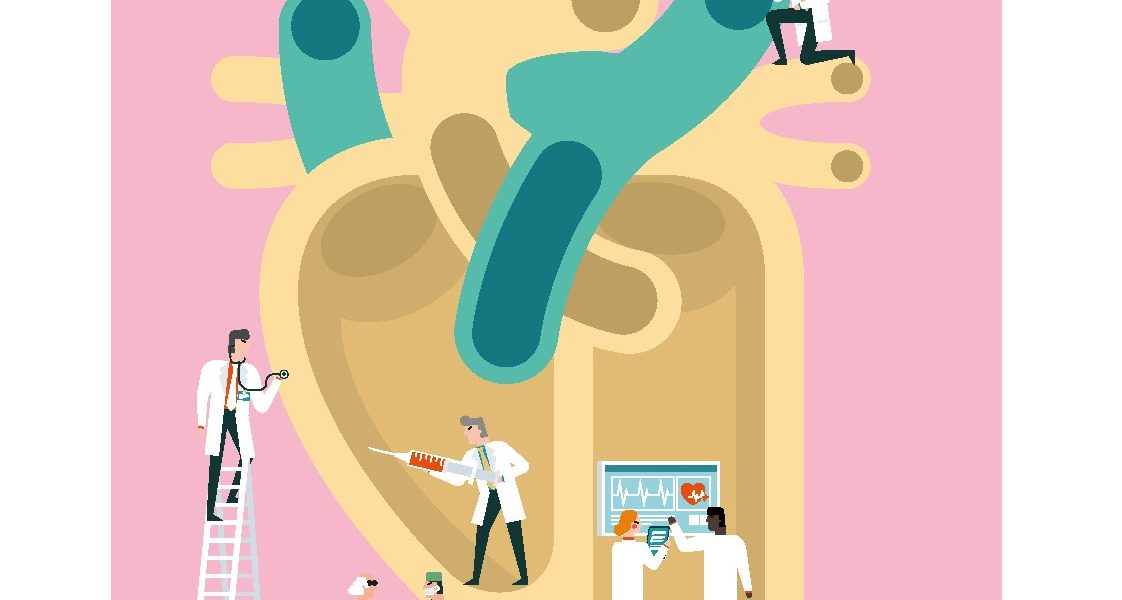Want some inside info on your ticker? Our heart health experts are here to help you understand the most common conditions
There are around 7.4 million people living with heart and circulatory diseases in the UK, according to the British Heart Foundation. That being said, it can be hard to visualise and imagine what a healthy heart looks and feels like. Many of us only think about our hearts when it comes to exercise and in terms of our heart rate. Luckily, our experts have summarised some of the more prominent conditions and what you can do to keep this organ in great shape.
Could I have angina?
“Angina is when the blood supply to the heart is compromised due to narrowing of the blood vessels,” says Professor Mamas, a leading heart expert at Keele University. “It’s most commonly felt when a patient tries to exert themselves and when the symptoms listed below typically follow a pattern, so for example, when walking to the shops or running for a bus. With unstable angina, the symptoms can occur much more frequently than normal and may even happen when you’re resting.”
Symptoms:
The symptoms of angina vary from person to person. Common symptoms may include:
- Chest pain (tightness or heaviness) that may spread to your left arm, neck, jaw or back
- Breathlessness
- Tiredness
Treatment:
“For people with stable angina, it’s important to make lifestyle changes such as losing weight, quitting smoking and controlling your blood pressure,” says Professor Mamas. “We also prescribe drugs such as aspirin to inhibit platelets (tiny blood cells) sticking together to reduce the risk of heart attack; statins to reduce cholesterol levels; and anti-anginal drugs that either cause the blood vessels supplying to increase blood flow or reduce the energy requirements of the heart. Unstable angina is more serious, and patients should seek medical attention – particularly if they’re getting these symptoms at rest.”
If you think you’re experiencing a heart attack, then you should call 999 for an ambulance, sit down and try and stay calm, take a 300mg aspirin if you have one within reach and wait for the paramedics to arrive.
Q&A
What does a heart attack feel like?
Research conducted by the NHS has shown that women tend to wait longer to call 999 after experiencing heart attack symptoms – so it’s important to be aware of what happens. According to the British Heart Foundation, the most common signs include: pain or discomfort in your chest that is sudden and doesn’t go away, pain that spreads to your left or right arm or to your neck, jaw, back or stomach. For some people the pain or tightness is severe, while for others it’s uncomfortable and they feel sick, sweaty, lightheaded or short of breath.
What are inherited heart conditions?
Heart conditions can often occur in families because of a faulty gene. “The most common involve the heart muscle structure, affecting how well the heart can pump,” says Philippa Hobson, a senior cardiac nurse at the British Heart Foundation.
Symptoms:
Symptoms aren’t always apparent with inherited conditions, but some include:
- Dizzy spells
- Palpitations
- Blackout
- Shortness of breath
It can be hard to diagnose an inherited heart condition, so if you are concerned you should speak to a doctor or cardiologist. Things to consider carefully are:
- If a member of your family has an inherited heart condition.
- If there’s been cardiac arrests or premature deaths in your family.
- There’s a family history of very high cholesterol.
“If you’re a relative of someone who has been diagnosed with an inherited heart condition (IHC), it’s recommended that you’re referred to a specialist centre,” says Phillipa. “Here, you’ll be tested to see if you have the same faulty gene as your family member. This type of genetic testing through families is called cascade testing.”
Treatment:
“Different inherited heart conditions require different treatments and your doctor or specialist will explain what’s right for you,” says Phillipa. “Some examples of treatments for an IHC can include: medication or implantable cardioverter defibrillators (ICDs).”
For more information on inherited heart conditions, please visit the British Heart Foundation website, (bhf.org.uk).
What is valve disease?
“The heart is a pump with four distinct chambers,” says Dr Jonathan Byrne, a consultant cardiologist at London Bridge Hospital (hcahealthcare.co.uk). “Valves control the flow of blood into and out of the large chambers which are known as the ventricles. Valve disease is any condition which causes the valves to leak (regurgitation) or narrow (stenosis). Most commonly it develops with age as the valve structure and function degenerates. It can also occur after infection, a condition known as infective endocarditis.”
Symptoms:
The symptoms of a heart valve problem will depend on the type and severity of the valve leak or narrowing, but in general will usually cause breathlessness and a reduction in exercise tolerance. “These symptoms can develop very slowly over a long period of time,” says Dr Bryne. “Any loss of consciousness during activity may suggest a valve problem, and should always prompt further assessment and investigation.”
Treatment:
“Valve disease can be treated with medication, but once a severe narrowing or leak has occurred then replacement or repair is usually needed,” says Dr Byrne. “The usual treatment for severe valve problems is surgery, where the heart is stopped to allow the surgeon to fix the leak or narrowing. A number of less invasive keyhole procedures are now available and are now being carried out on lower risk patients with excellent results.”
A guide to your healthiest heart
More than half of all adults in England have raised cholesterol levels, while one in three have high blood pressure, according to the cholesterol charity Heart UK. Heart health is easy to take for granted, but by making a few simple tweaks to our diet and lifestyle, we can help to protect it, as nutritionist Lily Soutter tells us:
Polyphenols
“While all fruit and veg contains an array of polyphenols, berries are unique in that they contain a high content of the polyphenol, anthocyanin, which is thought to have heart protective effects,” says Lily. “Data gathered from the Nurses’ Health Study showed that women who consumed the highest amounts of blueberries and strawberries were 34 percent less likely to suffer from a heart attack than women who ate the least of these fruits.” The best sources? Blueberries, blackberries, strawberries and raspberries.
High fibre foods
“As a population we currently only consume an average of 15-18g of fibre per day, which is just half our recommended 30g!” says Lily. “If you’re suffering with high cholesterol, then soluble fibre is just too important to go amiss. This special fibre binds to ‘bad’ LDL cholesterol and bile acids in the digestive tract. This means that cholesterol is eliminated from the body rather than absorbed into the bloodstream. Top sources of soluble fibre include: oats, oat bran, berries, beans, lentils, psyllium and flax seeds.
Vitamin C
“We all know that fruit and vegetables are good for us, and people who eat more have been shown to have higher blood levels of vitamin C, which has been associated with a reduced risk of cardiovascular disease,” explains Lily. “Vitamin C is an antioxidant nutrient, and test tube and animal studies have shown that this nutrient contributes to a reduction in the oxidation of harmful cholesterol. Two top sources of vitamin C are berries, in particular, strawberries.”
Oily fish
“Oily fish is extra-special as it’s a potent source of omega 3 fats,” says Lily. “These healthy fats may help to protect heart and blood vessels from disease. Try to eat two portions a week if you can.”




















